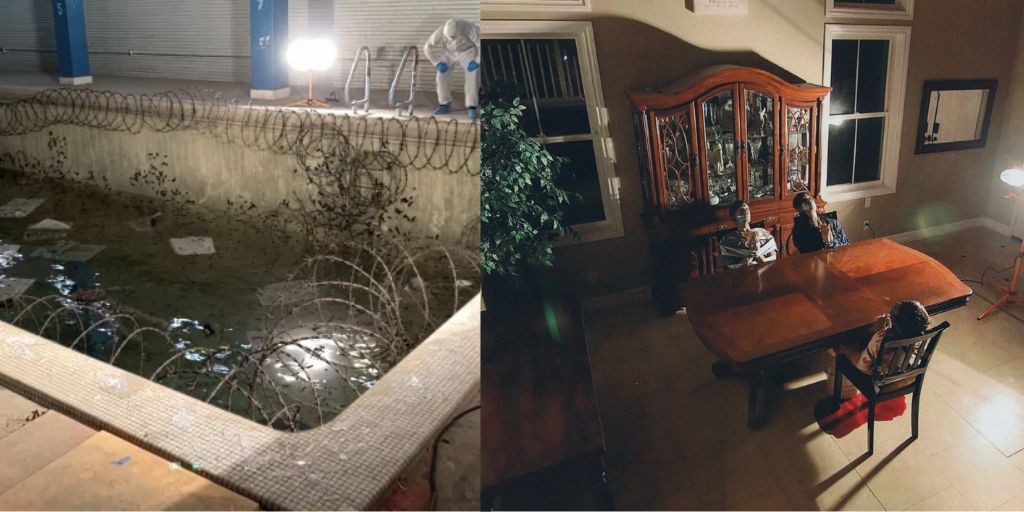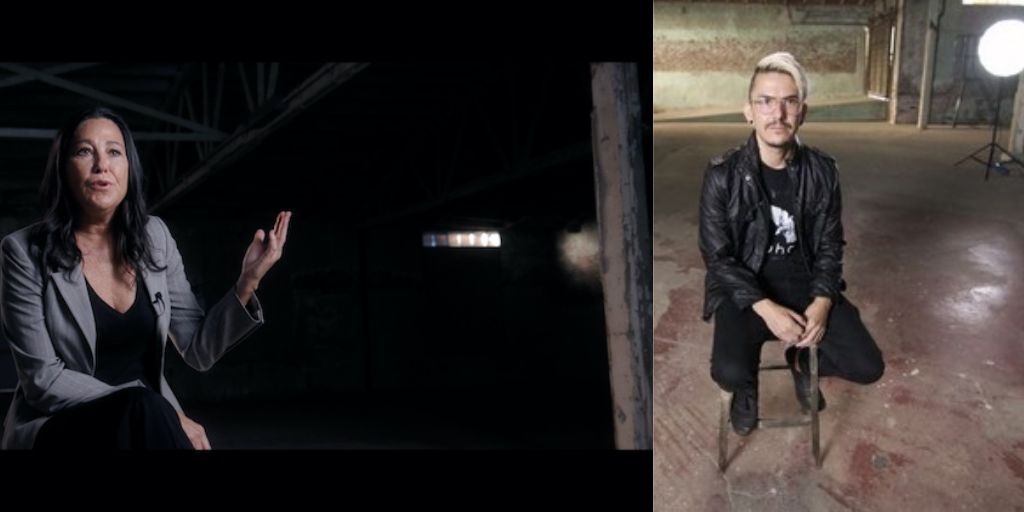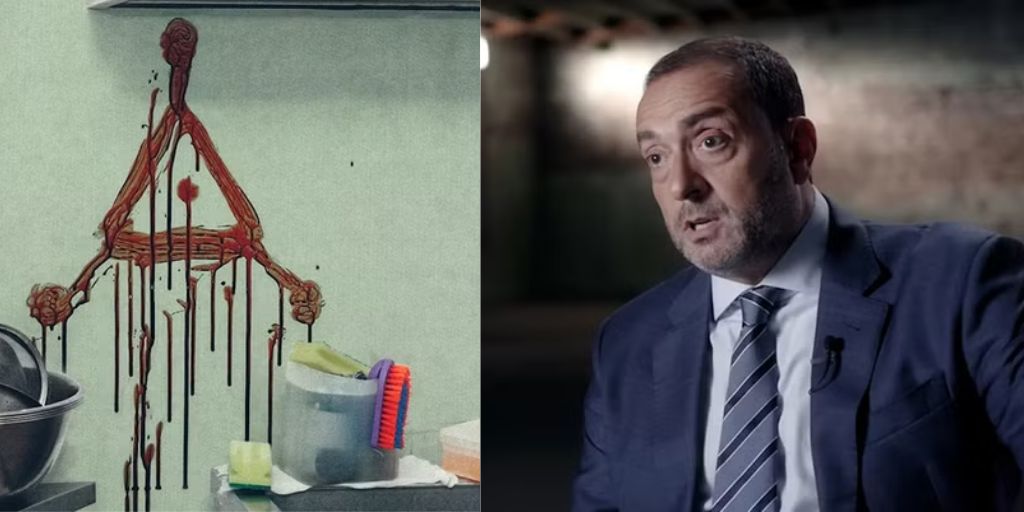Strange Harvest: Occult Murder in the Inland Empire expands on the typical horror narrative by creating a complex atmosphere that combines fear with reality. Stuart Ortiz uses techniques that make viewers feel they are watching real events, deepening the unease throughout the film.
The film’s pacing, structure, and detailed world-building give viewers an unsettling experience that blurs the line between fiction and reality. The disturbing scenes and realistic interviews don’t just frighten viewers but also immerse them in a world that feels alarmingly close to reality.
The main character, Leslie Sykes, or “Mr. Shiny,” is portrayed in a way that gives the illusion of authenticity. His character is inspired by classic horror figures but has unique qualities that make him memorable. The film reveals his disturbing obsession with leeches and a celestial entity he hopes to call upon through his cruel acts.
Mr. Shiny’s fascination with these elements adds layers to his character, making him more than just a stereotypical villain. He becomes a complex and terrifying figure whose actions are motivated by a twisted belief system. This not only intensifies the horror but also hints at a supernatural dimension, which elevates the fear factor as it suggests a force beyond human control.
Throughout the film, Ortiz ensures each scene adds to the tension and mystery surrounding Mr. Shiny. For instance, the interspersed footage and news reports contribute to a growing sense of dread, as they offer clues and look into the horrors that have taken place.
These pieces of information are presented strategically, allowing viewers to piece together the puzzle slowly. Ortiz does not bombard viewers with too much information at once, which helps maintain suspense and keeps the audience engaged. By spacing out the horror elements, he builds an atmosphere that feels both unpredictable and frightening.

Ortiz also goes to great lengths to make the setting feel authentic. The film’s locations, from gritty alleyways to abandoned buildings, are chosen carefully to reflect the dark themes of the story. Each location adds to the bleak and oppressive mood, making viewers feel as though they are walking through a place where evil has thrived.
Ortiz combines these settings with sound effects that enhance the horror. The eerie silence before a sudden noise or the faint, unsettling background sounds makes viewers feel as if they are hearing the sinister whispers of Mr. Shiny’s world. Every detail, from the lighting to the camera angles, is designed to heighten the terror.
The documentary style serves as a unique storytelling method, providing a fresh approach to horror. Interviews with various people, including detectives, survivors, and family members of the victims, give a sense of realism that traditional horror films often lack.
Ortiz has crafted each character to feel genuine. For instance, Detective Joe Kirby’s portrayal captures the frustration and desperation of a man haunted by an unsolved case, while survivor Glen Sandweiss’s scars serve as visual reminders of the trauma he has endured. Each character’s reactions and expressions are subtle yet powerful, conveying the pain and horror they have experienced without overacting.
One particularly disturbing aspect of Strange Harvest is the portrayal of Mr. Shiny’s brutal methods. His rituals are graphic and disturbing, intentionally crafted to shock viewers. The sacrificial altars, the symbols painted with blood, and the placement of severed heads in ritualistic formations show the extent of his depravity.
These scenes are reminiscent of extreme horror films but with a realistic edge that makes them even more horrifying. The acts feel deliberate and meticulously planned, emphasizing Mr. Shiny’s belief in the dark forces he seeks to summon.
Ortiz has a skill for combining disturbing imagery with subtle psychological horror. For example, while the gore is shocking, it is the underlying suggestion of Mr. Shiny’s connection to supernatural forces that creates lasting fear. The references to the 13th Zodiac sign, Ophiuchus, add a layer of mystique and hint at a cosmic alignment that drives Mr. Shiny’s horrific actions.
This aspect of the film taps into primal fears, suggesting that his actions are part of a larger, incomprehensible plan. It is not just a series of murders; it is a ritual meant to bring about something sinister and unstoppable.
The film’s pacing also contributes to its effectiveness. Ortiz balances the horror with slower moments that allow viewers to process what they have seen before the next shock. He uses these moments to find the emotional toll on the characters, showing how the murders have affected their lives.
By giving viewers a chance to connect with the characters’ pain, Ortiz deepens the horror, making each scene more impactful. While Strange Harvest succeeds in creating a haunting atmosphere, it occasionally struggles with genre clichés.
The documentary format includes some moments where the interview subjects deliver lines in a theatrical manner, which can break the illusion of realism. Lines like “…but it wasn’t over…” are intended to build suspense, but at times, they feel forced.
However, Ortiz compensates for these occasional missteps by keeping the horror grounded. Despite the scripted elements, the film remains effective in creating a disturbing and believable world.
Strange Harvest stands out as a horror film that goes beyond typical scares. Ortiz’s attention to detail and commitment to authenticity make it more than just a fictional story. It is a psychological tale of fear, trauma, and the dark forces that drive people to commit unspeakable acts.
By blending realistic horror with supernatural elements, Ortiz has crafted a film that feels deeply unsettling and profoundly terrifying. Strange Harvest expands the boundaries of horror by blending authenticity with an unsettling, almost mythical sense of dread.

Stuart Ortiz’s commitment to creating a world that mirrors reality leaves viewers questioning the line between fiction and true horror. The unsettling realism is intensified by Ortiz’s choice of mockumentary format, which brings viewers closer to Mr. Shiny’s world and invites them to experience the terror in a deeply personal way.
The film goes into the psyche of a murderer who isn’t just driven by bloodlust but by a disturbing belief system that enhances his horrific acts to a form of ritualistic worship. This eerie conviction adds a layer of psychological horror, making Mr. Shiny’s character both terrifying and complex.
Ortiz’s storytelling keeps the suspense alive, strategically revealing details that unravel Mr. Shiny’s twisted mind without overwhelming the audience. Each gruesome scene serves as a reminder of the dark powers he believes in, drawing viewers into a web of suspense and terror that feels all too plausible.
By infusing supernatural undertones with tangible, real-world settings, Ortiz not only delivers scares but also leaves a lasting impact. The eerie combination of psychological horror, authentic settings, and supernatural mystery makes Strange Harvest a haunting story of human fears—both seen and unseen.
Through masterful pacing, atmospheric tension, and an original storyline, Ortiz crafts a film that is as thought-provoking as it is terrifying, offering audiences a profound experience that resonates long after the screen fades to black.





